Abstract
Organic mulches can suppress annual weeds and offer other important benefits, such as organic matter, nutrients, moisture conservation, soil protection, and moderation of soil temperature. Drawbacks include costs and labor of application, limited efficacy on perennial weeds, delayed soil warming, and the potential to carry weed seeds and harbor pests.
Hay, straw, and fresh-cut forage or cover crops are among the most versatile and widely-used organic mulches. They can suppress weed germination and emergence when applied at reasonable rates, are fairly easy to apply, reduce evaporative losses of soil moisture while allowing rainfall to reach the soil, and provide other benefits. Caution is needed to avoid bringing in weed seeds or herbicide residues with hay from off-farm sources. Tree leaves, chipped brush, and other forest-based mulches are often beneficial to small fruit and other perennial crops, but may not be an economical option for weed control at a multi-acre scale. This article explores in greater depth the properties, uses, advantages, and disadvantages of a variety of organic mulch materials.
Introduction
Organic mulch materials include grain straw, fresh or old hay, fresh-cut forage or cover crops, chipped brush, wood shavings, tree leaves, cotton gin waste, rice or buckwheat hulls, and other crop residues. Hay and straw are among the most widely used organic mulches in organic horticulture. Cover crops can be grown to maturity (flowering), mechanically killed, and left on the soil surface to provide an in-situ organic mulch for no-till planting. Leaf mold (decomposed tree leaves), compost, and aged manure have also been used as organic mulches, although their crumbly texture may not provide as effective a barrier to weed seedlings as other materials.
Organic mulches suppress weeds in several ways. First, they block seed germination stimuli by intercepting light, reducing soil temperature, and greatly dampening day–night temperature fluctuations. As a result, fewer weed seeds germinate under the mulch than in uncovered soil. Second, the mulch physically hinders emergence of those weeds that do germinate. If the mulch is thick enough to prevent light from reaching the trapped seedlings, they eventually die. Third, some mulch materials, such as grain straw and fresh-cut forages like sorghum-sudangrass, release natural substances that inhibit weed seedling growth for several weeks after application, a process known as allelopathy. Finally, organic mulch can enhance crop growth and competitiveness against weeds by conserving soil moisture and moderating soil temperature.
Straw and other organic mulches effectively block emergence of most weeds germinating from seed, although grasses and large-seeded broadleaf weeds may require a greater thickness of material than small-seeded broadleaf weeds, which have more delicate seedlings. Perennial weeds arising from rootstocks, rhizomes, tubers, or other vegetative propagules can penetrate most organic mulches.
Weeds that have already emerged at the time of mulch application should be cultivated or hoed out before spreading mulch; simply laying the organic materials over established weeds is less effective. once the weeds break through the mulch, they will enjoy the same mulching benefits as the crop, and will grow vigorously.
Usually, some weeds will eventually emerge through an organic mulch. Fast-growing, canopy-forming crop like sweet potato, squash, or snap bean often shade-out these late emerging weeds. In slower-growing, less competitive vegetables like onion and carrot, manual weeding or application of additional mulch may be required to maintain satisfactory weed control.
Hay
Hay is often used to mulch horticultural crops in regions such as southern Appalachia, where the predominant farming systems include hay production, and old hay is more affordable than straw and other materials. Hay has some drawbacks and must be chosen and used with care. However, it is fairly easy to apply in small scale plantings, and is usually beneficial to soil quality and crop production (Fig. 1). A hay mulch of about 3–4 inch thickness can:
- Reduce emergence of weed seedlings, especially small–seeded broadleaf annuals.
- Provide habitat for beneficial organisms, including ground beetles and other weed seed consumers.
- Allow air and rain to reach the soil.
- Moderate soil temperature during hot weather.
- Conserve soil moisture.
- Prevent soil crusting and erosion.
- Keep pumpkins, melons, and other fruiting crops out of direct contact with soil, and therefore cleaner.
- Add significant amounts of organic matter and slow-release nutrients, especially potassium (K).
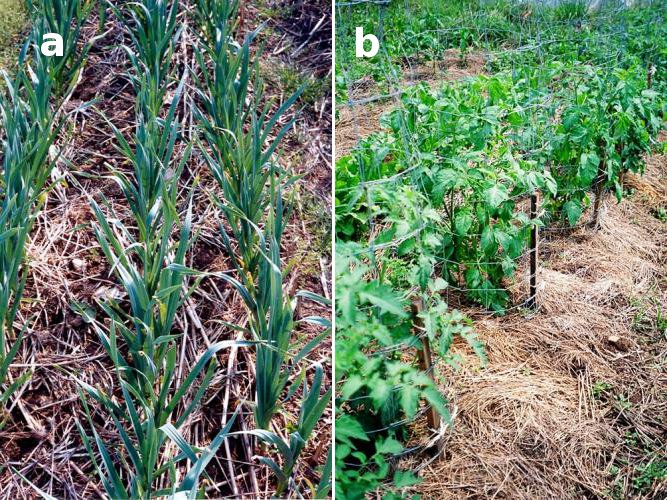
Figure 1. (a) Garlic mulched with hay immediately after planting in October; photographed in April. (b) Tomato mulched with hay after the crop became established, several weeks before the photo was taken. The mulch delayed weed emergence and provided favorable conditions for crop growth. Photo credit: Mark Schonbeck, Virginia Association for Biological Farming.
Hay also has some significant drawbacks, in that it:
- Does not suppress most perennial weeds.
- May contain weed seeds (Fig. 2) or herbicide residues (see Sidebar).
- Can harbor slugs, squash bugs, voles, and other pests.
- Can keep the soil too cool or wet, slowing crop growth or maturation.
- Can accentuate frost damage by keeping the soil's radiant heat from reaching crop foliage.
- Can build up excessive soil K levels when used year after year.

Figure 2. This hay was cut too late in its development, and carried mature seeds. As a result, forage grasses (fine–textured seedlings) are growing in this cucumber bed. Additional weeds have emerged from the soil's weed seed bank because the mulch application was not sufficiently heavy to cover the soil surface completely. Photo credit: Mark Schonbeck, Virginia Association for Biological Farming.
Sidebar: Hay Mulch—Check Your Source!
Hay from off-farm sources is a notorious source for new and serious weed species on a farm. Even in fields with good weed management, hay that has been cut too late in its development will carry seeds of the forage species themselves, which can be a nuisance if they come up in a vegetable crop. In addition to weed seed, the grower must be alert to the possibility of herbicide residues.
Some grass hay is produced with the use of weed control products that contain highly persistent active ingredients, including clopyralid, aminopyralid, picloram, and aminocyclopyrachlor, all of which are highly toxic to broadleaf plants. Hay from fields treated with any of these materials can cause severe damage to tomato family, cucurbit family, and other vegetable crops around which the hay is applied as mulch (Plaksin and Bynum, 2007). Symptoms include curling and twisting of leaves and petioles (leaf stalks), and stunted growth, which can lead to crop failure or plant death. Subsequent vegetable or broadleaf cover crop plantings may continue to show symptoms for a year or more after initial contamination, and the field may lose eligibility for organic certification until herbicide residues have disappeared.
These herbicides are not degraded by composting. If horses or cattle graze or eat hay from treated fields, and their manure is hot-composted, cured for a year, and applied to vegetable beds, the vegetables can still suffer damage.
It always pays to check with the farmer who grew the hay regarding weed management practices, herbicide use, and time of cutting relative to forage seed set, before bringing hay onto the farm for use as mulch on horticultural crops.
Not all hay is alike. Grass hay is lower in nitrogen (N) and phosphorus (P), higher in K, and more persistent and weed-suppressive than legume hay. Because of its high cargon-to-nitrogen (C:N) ratio, grass hay has sometimes been reported to tie up soil N. However, this is most likely to occur when the hay is incorporated into the soil, not when it is applied to the surface as a mulch. A grass–legume mix (such as timothy–alfalfa, fescue–red clover, or rye–hairy vetch) yields a more balanced mulch that provides slow release nutrients to soil life and crops, and persists long enough to provide several weeks of weed suppression.
Fresh hay is more pleasant to spread but more likely to contain large numbers of viable weed seeds than old, spoiled hay. Second or third cuttings of hay are especially likely to have weed seeds (Mohler and DiTommaso, unpublished). Leaving hay bales or rolls in the rain for a year or so reduces weed seed viability, but moldy hay can be nasty and hazardous to handle, and does not provide as clean or long-lasting a mulch. A better solution is to grow and harvest mulch hay on farm, taking care to cut the mulch crop before viable seeds are formed. Mulch hay can be derived from perennial forages or annual cover crops (rye, sorghum-sudangrass, etc.). Note that repeated hay harvests from a given field can deplete soil nutrients, notably P, K, and calcium (Ca). Crop rotations that alternate annual or perennial mulch crops with vegetables that receive the mulch can promote better nutrient balance by minimizing the nutrient depletion of hay harvest while avoiding the potential K excesses from repeated mulch application.
Applying hay manually is most feasible at a small scale, for example, a half acre of a high value crop. A few farmers have used bale choppers to mechanize application of hay or straw in small rectangular bales. Large rolls (round bales) are commonly unrolled between rows of widely spaced crops like tomato, a job which usually requires a tractor to place the ~1,000 lb roll at the beginning of the crop row, and two people to unroll it.
A number of farmers have streamlined on-farm harvest and application of mulch by using a flail chopper and forage wagon for harvest, and then pitchforking the fresh-cut forage off the wagon as it is pulled slowly along crop rows (Kittredge, 2008–09a). Other producers, including David Stern of Rose Valley Farm in upstate New York, grow alternate rows of vegetable and cover crop (e.g., potato and sorghum-sudangrass), and periodically mow the cover crop, blowing the clippings into the vegetable row as mulch (Schonbeck, 2007). This approach saves the labor and costs of curing, baling, and storing hay. However, fresh grass or legume "green chop" has been reported to promote certain soil-borne pathogens for a short period after application (Mohler and DiTommaso, unpublished); thus, fresh-cut forage mulches should be tested on a small area for each crop before field-wide application.
Some tips for optimal use of hay mulch for weed control:
- Grow and use on-farm hay if practical.
- Check sources of off-farm hay for weed seeds and herbicide residues before purchasing.
- Apply mulch when crops are well established, and soil temperature and moisture are optimum for the crops being grown (exception: fall planted garlic is mulched immediately after planting).
- Hoe or cultivate at the beginning of a warm sunny day, wait 12–36 hours to let uprooted weeds die, then spread mulch (applies to all organic mulches).
- Use enough hay to suppress most weed seedlings, about 3–4 inches or 5–10 tons per acre.
- Monitor soil nutrient levels, especially K.
- Rotate mulched vegetables with non-mulched crops or hay production.
Straw
Straw, defined here as the stalks and other residues left after harvest of a mature grain, is similar to hay in texture, potential for soil protection and moisture conservation, weed suppression, and application methods. Straw differs from hay in that it:
- Has higher carbon to nitrogen (C:N ratio).
- Provides a cleaner, more persistent mulch that is slower to decompose, and more effective in keeping the fruit of pumpkin and other vine crops clean.
- May carry seeds of the grain crop itself, but is less likely to carry other weed seeds.
- Has somewhat lower K levels and slower K release.
- Is lighter colored and more reflective, hence it may cool soil more than hay.
Because straw is so much less likely to introduce serious new weed problems than hay, organic horticultural farmers located in or near grain-producing regions where straw is available and affordable often prefer straw over hay. The high C:N ratio of straw precludes much release of N from mulch to the current year's crop, but usually does not lead to tie-up of soil N, as long as the mulch lies on top of the soil and is not tilled in.
The dramatic soil cooling under straw can delay crop growth (Fig. 3); however it can be beneficial for cool weather crops like potato, in which tuber growth is inhibited by soil temperatures above 70°F (Fig. 4a); and for other crops during hot summer weather (Fig. 4b). For example, tomato shows optimal nutrient uptake and production at root zone temperatures of 70–85°F, and becomes stressed at higher temperatures (Abdul-Baki and Teasdale, 1994, Tindall et al., 1990, Tindall et al., 1991); thus, it often performs better in organic than in plastic mulches during the heat of summer. Bright, reflective straw can intensify heating of crop foliage under a row cover, resulting in crop damage (Kittredge, 2008–09a), and may also increase damage from frosts.

Figure 3. The light colored grain straw was applied too early in the season. The mulch has suppressed weeds, but also seriously delayed soil warming and tomato growth (compare to plastic mulched tomato in upper left). Photo credit: Mark Schonbeck, Virginia Association for Biological Farming.
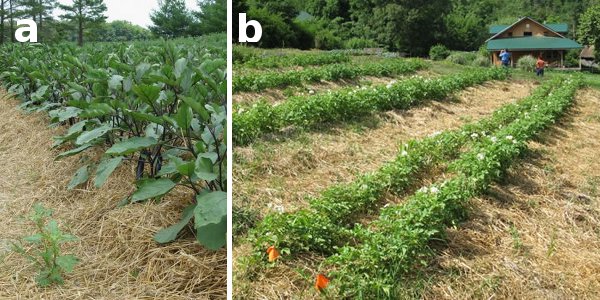
Figure 4. (a) Potato tuber yields are often enhanced by the cooler soil conditions under a straw mulch. (b) The straw was applied after the soil had warmed to optimal temperatures for eggplant, and is now helping the crop thrive during intense summer heat. A few weeds have emerged at this point, but are unlikely to affect yield in the vigorous, established eggplant crop. Photo credit: Mark Schonbeck, Virginia Association for Biological Farming.
Rye, wheat, and other grain crops cut for mulch at an earlier stage of maturity (e.g., head emergence or pollen shed) are richer in nutrients and less likely to immobilize soil N than straw left by grain harvest. Rye, triticale, and other winter grains cut at the milk stage (before the seeds become viable) yields excellent straw for mulch, and minimize the risk of volunteer cereal grains becoming a weed (Fig. 5). Cereal grain cover crops rolled down at the milk stage are particularly popular for no-till pumpkin production, as they help keep the fruit clean, reduce soilborne diseases, and promote even color development (Ron Morse, Virginia Tech, pers. comm.).

Figure 5. Self-seeding of cereal grain occasionally causes a weed problem in straw mulch. In order to avoid this problem, some farmers grow their own grain straw for mulch, and harvest the mulch crop before seeds become viable. Photo credit: Mark Schonbeck, Virginia Association for Biological Farming.
Tree Leaves
Hardwood leaves that fall naturally in autumn are sometimes used as mulch in vegetable production (Fig. 6a). They are rich in calcium (Ca) and micronutrients, contain small to moderate amounts of N, P, and K, and decompose gradually to form leaf mold, a humus-like material that is valued by horticulturists. Millions of suburban residents rake up autumn leaves for disposal, and a growing number of farmers and other entrepreneurs accept leaves for mulch or for making compost. Leaves are often used for berries and some other perennials that tolerate or prefer some acidity. Pine needles (pine straw) are lower in nutrients, more persistent, and more acidic than hardwood leaves, and can be especially useful for blueberries, which require a low pH (Fig. 6b). Tree leaves are much less likely than hay to carry the seeds of agricultural weeds; however, they have been observed to carry tree seeds (especially maple or ash), which germinate into vigorous seedlings that readily emerge through the mulch.
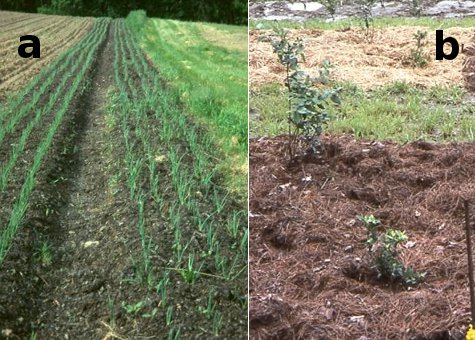
Figure 6. (a) onion mulched with tree leaves gathered the preceding autumn at Potomac Vegetable Farms in Vienna, VA, near Washington, DC. (b) New blueberry planting in Floyd, VA mulched with pine needles (foreground) and grain straw (background). Photo credit: Mark Schonbeck, Virginia Association for Biological Farming.
Some disadvantages of tree leaves as a mulch include:
- A tendency to mat down when wet, creating soggy or airless soil conditions.
- A tendency to blow away in the wind when dry, or to blow onto and smother young crop seedlings.
- Labor intensive application, not feasible at a larger scale.
- Presence of trash (cans, glass, plastic, etc.) in municipal leaves or yard waste.
The soil benefits of tree leaves can also be realized by including them in compost piles, or making leaf mold (leaves aged for 1–2 years until crumbly), which is an excellent soil amendment or potting mix ingredient.
Chipped Brush, Wood Shavings, Bark
These forest product mulches are most often used on perennial crops such as berries (Fig. 7) and ornamental perennials, many of which like a somewhat acidic soil rich in mycorrhizae and other beneficial fungi supported by these materials. They tend to be coarser and higher density than hay or straw, require higher tonnage per acre to suppress weeds, and may not be economical for most larger-scale applications. Other characteristics include:
- High C:N ratio.
- Relatively long lived.
- Allelopathic properties when fresh, especially walnut and some conifers (softwoods).
- Provide calcium (Ca), micronutrients, and small amounts of N, P, and K.
- Formation of stable humus when fully decomposed.

Figure 7. A perennial variety of strawberry in a garden in Floyd, VA thrives and yields well in a mulch of chipped brush, aged about one year before application. Photo credit: Mark Schonbeck, Virginia Association for Biological Farming.
Wood based or bark mulches should be aged for at least a year outdoors before application near crop rows, to minimize possible allelopathic suppression of crop growth. However, fresh chipped brush can be useful for suppressing weeds in paths or alleys between beds. one grower in New Jersey has had excellent results with 1–2 year old hardwood chips as mulch, and 8–11 year aged hardwood chips as a soil amendment for blueberry (Kittredge, 2008-09b).
Wood chip and bark mulches should not be piled against the bases of trees or shrubs, as this can promote the development of fungal diseases. Limit mulch depth to 1–2 inches adjacent to and within 6–12 inches from the base, then increase the depth further away.
Sawdust
Sawdust is chemically similar to other wood products, but because it is so finely divided, it has the following disadvantages as a mulching material:
- Tends to mat down and keep soil wet and airless.
- Can tie up soil N as small particles or soluble carbohydrates leach into the soil.
- Can be quite allelopathic against crops for a short time.
- May be penetrated by some weeds, and may provide a good germination medium for wind-borne weed seeds.
- May be washed away by heavy rain on sloping fields (Fig. 8).
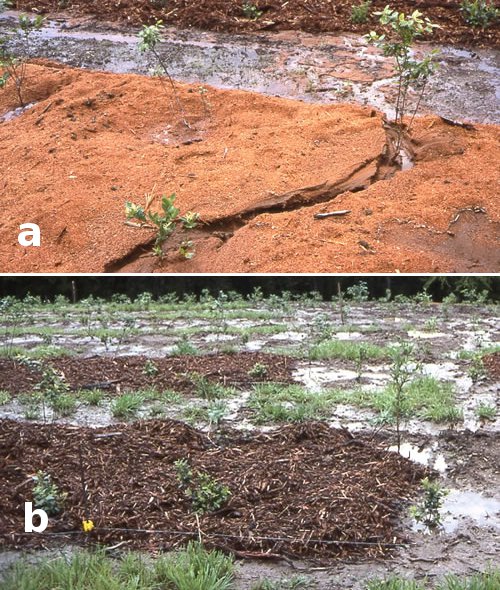
Figure 8.(a) An intense rainstorm has washed a fine sawdust mulch away from newly planted blueberries. (b) The same storm damaged soil structure in un-mulched beds (right and background), whereas chipped brush held firm, protecting both soil and crop (left foreground). Several years after these photos were taken, the blueberry bushes mulched with sawdust remained visibly smaller than those in other mulches, as a result of N immobilization by the fine sawdust. Photo credit: Mark Schonbeck, Virginia Association for Biological Farming.
Compost
A few growers use compost as mulch, although the quantities required for effective weed suppression may not be economically feasible. In a study in Virginia, 1½–2 inches of leaf mold compost (50–90 tons per acre) did not suppress weeds quite as well as 4 inches (~8 tons per acre) of hay (Fig. 9) (Schonbeck, 1998). Compost is much more effective and economical to use as an ingredient in potting mixes (at 10–50% of total volume), or as a soil amendment at 1–10 tons/ac to inoculate the soil with beneficial organisms, provide slow-release nutrients, and improve soil structure. Higher application rates, such as those used in the study, commonly leads to excessive levels of P, K, and some micronutrients in the soil. The surplus P and K can favor the growth of weeds over crops in subsequent years.
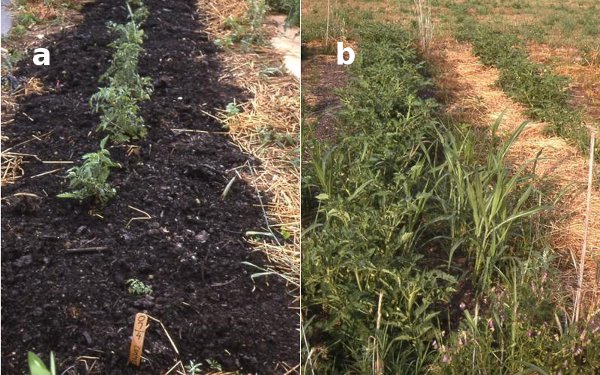
Figure 9. Mulching with compost (a) A municipal compost, based primarily on tree leaves, was applied at 50 tons per acre in this trial. (b) By midsummer, considerably more weeds emerged through the compost than through a 4–inch (~8 tons per acre) hay mulch. Photo credit: Mark Schonbeck, Virginia Association for Biological Farming.
Manure
Manure is not recommended as a mulch for weed control. Many weed seeds pass through livestock digestive tracts unharmed, and the readily available nutrients in the manure stimulate weed growth. Lambsquarters (Chenopodium album) and spiny amaranth (Amaranthus spinosus)are just two of many nutrient-responsive weeds that are frequently spread in manure. Furthermore, uncomposted manure cannot be applied to USDA certified organic vegetable crops within 90–120 days of harvest, and applying sufficient manure to suppress weed seedling emergence from the soil is likely to create gross excesses of soil P and K.
Other Organic Residues
Crop residues—especially materials like cotton gin waste, rice hulls, peanut hulls, and buckwheat hulls—may be available in quantity in certain locales. Their ability to suppress weeds may vary, depending on texture and possibly chemical properties. Care should be taken to avoid crop residues that carry crop pathogens, weed seeds, or herbicide residues. Buckwheat hulls have been reported to attract cats using the mulched bed as a litter box, and thus may not be a good choice in neighborhoods with high cat populations.
Living Mulch
For many years, some growers have experimented with living mulches—perennial or annual cover crops growing between crop rows—in an effort to build soil quality while suppressing weeds. Experience has shown that living mulches allowed to grow in close proximity to crops often compete with the crop for moisture or nutrients, resulting in lower yields. However, in wide-spaced plantings, such as berries, alleys can be maintained in a perennial living mulch, while the area near crop rows are kept free of competing vegetation and mulched with straw, wood chip,or other organic materials (Fig. 10). Living mulches can also be planted in 2–3 foot wide strips between permanent vegetable beds to create firm, mud-free paths for tractor and foot traffic; define where workers and u-pickers should walk, and provide habitat for beneficial insects. Clippings from periodic mowing of the living mulch can be used to supplement organic mulch in crop beds.

Figure 10. A perennial living grass–clover mulch, maintained by regular mowing, maintains soil quality and suppresses weeds in alleys, while a 4-ft-wide zone for each row of blueberries is kept free of competing vegetation and mulched with straw and clippings from the alleys, to allow the new planting to become established. The grass-covered alleys also provide a better surface for foot traffic and minimize soil damage in u-pick berry fields. Photo credit: Mark Schonbeck, Virginia Association for Biological Farming.
References Cited
- Abdul-Baki, A. A., and J. R. Teasdale. 1994. Sustainable production of fresh market tomatoes with organic mulches. USDA Farmers' Bulletin FB-2279.
- Kittredge, J. 2008-09a. Mulching at Pleasant Valley Farm. The Natural Farmer 2(79): 32–39 (Winter 2008–09). (Available online at:http://www.nofa.org/tnf/Winter2008.pdf) (verified 12 Jan 2012).
- Kittredge, J. 2008-09b. 24 acres of mulch. The Natural Farmer 2(79): 13–18 (Winter 2008–09). (Available online at: http://www.nofa.org/tnf/Winter2008.pdf) (verified 12 Jan 2012).
- Mohler, C. L., and A. DiTommaso. Unpublished. Manage weeds on your farm: a guide to ecological strategies; version 5.1 (Cornell University, Dec. 4, 2008).
- Plaksin, E., and R. Bynum. 2007. Contaminated hay ruins crops. Growing for Market 16: 1, 4–7. (Available online at:http://www.growingformarket.com/articles/20071220_28) (verified 12 Jan 2012).
- Schonbeck, M. W. 1998. Weed suppression and labor costs associated with organic, plastic, and paper mulches in small-scale vegetable production. Journal of Sustainable Agriculture. 13: 13–33. (Available online at: http://dx.doi.org/10.1300/J064v13n02_04) (verified 12 Jan 2012).
- Schonbeck, M. W. 2007. Beating the weeds with low-cost cover crops, intercropping, and steel. The Virginia Biological Farmer 30: 7–8.
- Tindall, J. A., R. B. Beverly, and D. E. Radcliffe. 1991. Mulch effects on soil properties and tomato growth using micro-irrigation. Agronomy Journal 83: 1028–1034. (Available online at: https://www.crops.org/publications/aj/abstracts/83/6/AJ0830061028) (verified 12 Jan 2012).
- Tindall, J. A., H. A. Mills, and D. E. Radcliffe. 1990. The effect of root zone temperature on nutrient uptake of tomato. Journal of Plant Nutrition 13: 939–956. (Available online at:http://dx.doi.org/10.1080/01904169009364127) (verified 12 Jan 2012).
'庫間 > 해외자료' 카테고리의 다른 글
| 공장식 축산이 우리에게 보여주지 않는 것 (0) | 2013.03.23 |
|---|---|
| 농지 가격과 함께 농가부채도 치솟는다 (0) | 2013.03.23 |
| 농민장터는 성장하고 있지만 농민의 소득은 아니다 (0) | 2013.03.23 |
| 생물학적으로 다양한 생태계 서비스 대 관행농업 체계 (0) | 2013.03.23 |
| 다양한 유기농 작물이 야생 벌의 숫자를 늘린다 (0) | 2013.03.23 |